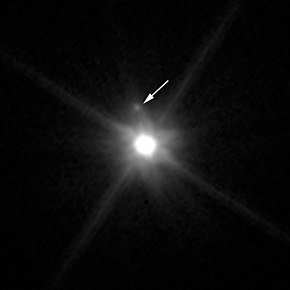|
S/2015 (136472) 1
S/2015 (136472) 1, unofficially nicknamed MK2 by the discovery team,[2] is the only known moon of the trans-Neptunian dwarf planet Makemake.[1][4] It is estimated to be 175 km (110 mi) in diameter and has a semi-major axis of at least 21,000 km (13,000 mi) from Makemake.[1] Its orbital period is at least 12 days if it has a circular orbit.[1][5][4] Observations leading to its discovery occurred in April 2015, using the Hubble Space Telescope's Wide Field Camera 3, and its discovery was announced on 26 April 2016.[2] Physical characteristicsS/2015 (136472) 1 is extremely faint, with an apparent magnitude of 25 in visible light.[3] The satellite is 1,300 times fainter than Makemake, which corresponds to a magnitude difference of 7.80 between it and Makemake.[6][1]: 3 Prior to the discovery S/2015 (136472) 1, measurements of Makemake's far-infrared thermal emission by the Spitzer and Herschel space telescopes showed that the dwarf planet emits more thermal radiation than expected for its size and brightness in visible light.[4] This led astronomers to suspect that Makemake must have extra dark surface area that is contributing to this excess thermal emission.[1]: 3 Makemake does not exhibit significant variations in brightness as it rotates, which leaves the possibilities that some of this dark surface area may either be uniformly distributed on Makemake's surface or is located on satellites orbiting Makemake.[4][1]: 3 [7]: 6 The discovery of S/2015 (136472) 1 lends credibility to the hypothesis that Makemake's excess thermal emission largely comes from satellites with dark surfaces.[7]: 6 Assuming S/2015 (136472) 1 has a uniformly dark surface, the satellite has a geometric albedo or visible light reflectivity of 2–4%, which makes it as dark as charcoal.[1]: 3–4 [6] The satellite is exceptionally dark compared to Makemake's geometric albedo of 82%; this may be because the satellite's gravity is too weak to hold on to bright, volatile ices as they sublimate off the satellite's surface into space.[1]: 4 [6] S/2015 (136472) 1 is estimated to have a diameter between 175–250 km (109–155 mi), based on its geometric albedo and brightness in visible light.[a] Within this range, S/2015 (136472) 1's diameter is most likely 175 km (109 mi) for a geometric albedo of 4%.[1]: 4 If S/2015 (136472) 1 has the same density as Makemake, then it would contribute less than 0.2% of the total system mass.[1]: 4 Additional satellites of MakemakeS/2015 (136472) 1 alone cannot be responsible for all of Makemake's excess thermal emission because its diameter and surface area only accounts for 20–30% of the total dark surface area.[1]: 3 [b] Even the maximum possible diameter of S/2015 (136472) 1 is too small to account for all of this dark surface area.[1]: 3 Furthermore, S/2015 (136472) 1 is too small to have tidally slowed down Makemake to its current rotation period of 22.8 hours.[7]: 6 These details indicate that there may be another large, undiscovered satellite orbiting Makemake. A satellite that is responsible for Makemake's slow rotation would have to be 3–5% of Makemake's mass and 400–550 km (250–340 mi) in diameter, which would be large enough to account for the remaining dark surface area. This undiscovered satellite would have to be closely orbiting Makemake at a distance of 3,000–5,000 km (1,900–3,100 mi), which would make it undetectable to current telescopes like Hubble.[7]: 6 It is possible that this undiscovered satellite has an irregular shape, which could account for most of Makemake's rotational brightness variability.[7]: 6 OrbitAlex Parker, the leader of the team that performed the analysis of the discovery images at the Southwest Research Institute, said that from the discovery images, S/2015 (136472) 1's orbit appears to be aligned edge-on to Earth-based observatories.[5] This would make it difficult to detect because it would be lost in Makemake's glare much of the time, which, along with its dark surface, would contribute to previous surveys failing to observe it.[1] Observations taken in 2018 and 2019 may be enough to determine whether the orbit is close to circular, which would suggest that S/2015 (136472) 1 was formed by an ancient impact event, or if it is significantly eccentric, which would suggest that it was captured.[6] NameAs of 2024[update], the satellite has no official name.[8] The designation S/2015 (136472) 1 is the satellite's provisional designation, with "S/" indicating satellite, "2015" being the satellite's year of discovery, and "1" being the satellite's order of discovery in that year.[9] "(136472)" is Makemake's minor-planet number.[10] The nickname 'MK2' simply means object 2 in the Makemake system. A permanent name may be chosen from an associated figure in the mythology of Easter Island.[citation needed] Notes
References
External links
|
||||||||||||||||||||||||||||||||||||








